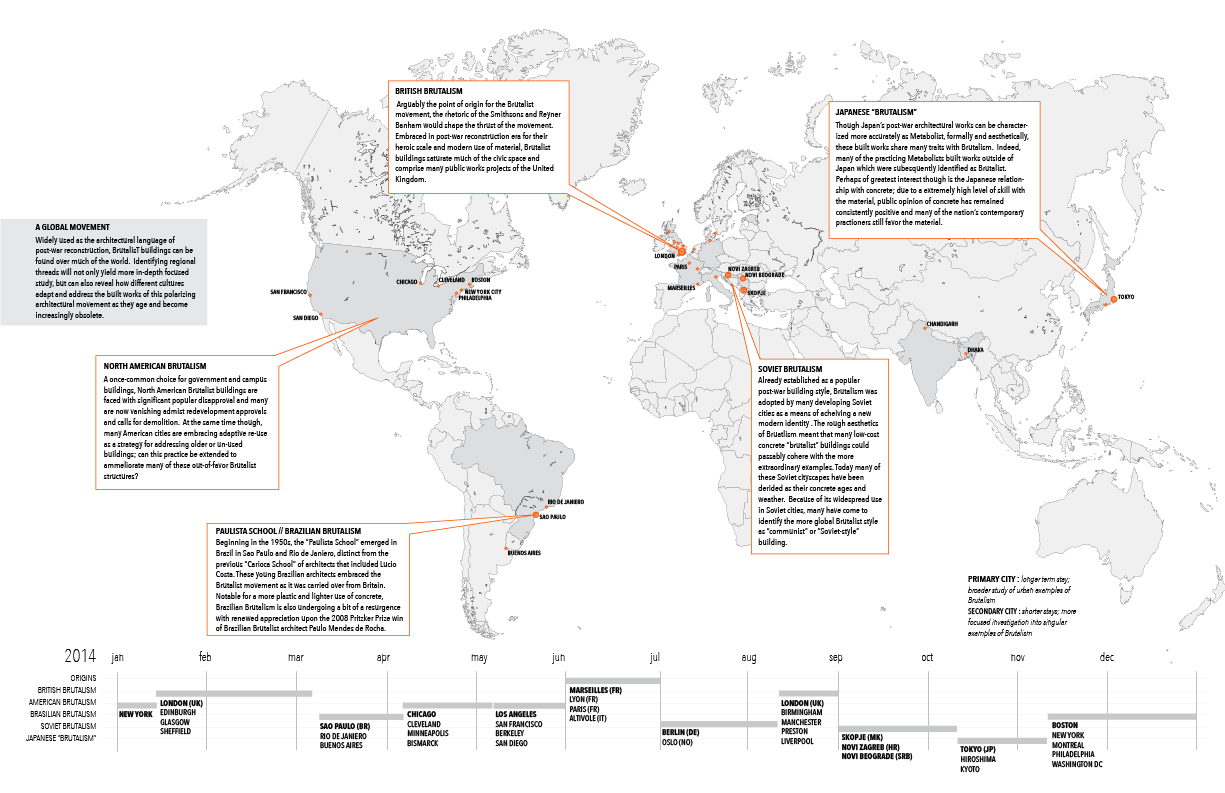John K Branner Fellowship
Awarded by the the University of California Berkeley College of Environmental Design, the Branner Fellowship is a travel award offered annually to Berkeley M.Arch. students who are beginning their design thesis. The fellowship supports 12 months of travel around the world in exploration of a particular architectural question or issue that may later be expanded as a thesis.
Context
Now approaching nearly fifty, sixty years of use, many structures of the post-war building boom are currently struggling to meet contemporary standards of performance and aesthetics, and have found themselves subject to the conflicting imperatives of demolition and preservation. Buildings associated with the Brutalist style find themselves today squarely in the middle of these debates, with many disappearing every year as cities across the globe update and rework their urban landscapes. While the term Brutalism was initially coined by Peter and Alison Smithson (as New Brutalism) in 1953 and then later elaborated on by Reyner Banham, today it has come to loosely describe heavy, monumental, typically concrete buildings built between the 1950s and 1970s. Many of these structures have fallen into disrepair, many more have fallen out of favor, and so the Brutalist label has come to be a rather pejorative one. Currently, many of those buildings identified as Brutalist, whether by their own designers or more frequently by the public, are at risk of demolition or have even already been lost.
The Considerations
CULTURE
Brutalist buildings have proven to be a divisive bunch and are more and more frequently targeted for demolition. Especially as of late, many of these buildings are disappearing every year as cities across the globe update and rework their urban landscapes.
What are the consequences of such widespread architectural loss?
MATERIAL
While not explicitly identified as a tenant of the movement, concrete has come to be a major identifying characteristic of these “Brutalish” buildings. This provides a unique opportunity to study how a single material was employed, detailed and finished in many different climates and cultures across the globe.
What lessons can be learned from such a widespread examination of a single material?
LOGISTICS
Concrete is often cited for the challenges in working within or adapting these buildings. As a monolithic, non-cavity, non-component construction system, concrete can be difficult to alter, yet by no means impossible.
Beyond this, the sparse detailing and lack of ornamentation makes these structures anything but precious. There is no delicate filigree to preserve, no relief to reconstruct which would all suggest a potential for more aggressive methods of reworking that embrace the rugged nature of these buildings.
Are these buildings as resistant to change as might have been suggested?
What opportunities does their rugged nature offer in terms of more aggressive methods of reworking?
The Itinerary
Personal Profile
Sarah Ramsey is a Master’s of Architecture student at the University of California at Berkeley’s College of Environmental Design. She received her Bachelor’s of Science in Architecture in 2007 from the University of Virginia. Born and raised in downtown New York City, she has a great affinity for urban environments, but never imagined she would be able to visit quite so many in just one year…
More of Sarah’s work can be found here.


Pingback: Why Brutalist Architecture Is So Hard to Love – Slate Magazine (blog) | Architecture
Pingback: Bostonians Hate Their City Hall, but Architects Love It – Slate Magazine (blog) | Architecture
Pingback: Hard to Love a Brute | 99% Invisible
Pingback: Concrete – Material Transformations